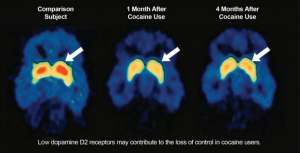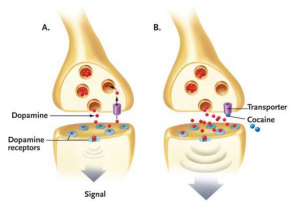ARTICLE OVERVIEW: Crack is a form of cocaine that is been changed to a free base, allowing it to be smoked. Compared with other drugs, crack is highly addictive. Being addicted to crack produces both changes in mood and changes in behavior. Some examples include being too nervous or alert, losing weight, or being careless about personal grooming. More signs and symptoms here.
TABLE OF CONTENTS:
- Crack Defined
- How It Works
- Onset of Action
- Effects on the Body
- Addictive Potential
- Signs of Addiction
- Treatment
- How To Get Help
- Your Questions
What Is Crack?
The DEA fact sheet on cocaine describes the production of crack like this: crack is made by converting cocaine hydrochloride to a chemical base by cooking it using ammonia or baking soda and water. When the substance hardens, it is placed in molds to dry and cut into chips or “rocks.” Crack is off-white in color and resembles hard shavings similar to slivers of soap or chips of cracked paint. [1]
Crack is nearly always smoked. Smoking cocaine delivers large quantities of the drug to the lungs, producing an immediate and intense euphoric effect.
How Crack Works
Crack affects the reward center of the brain. It rewires this center, so that regular users only feel good when they smoke. How does it work, exactly?
All types of reinforcing stimuli, such as food, sex, and many drugs of abuse, including cocaine, stimulate the brain’s mesolimbic dopamine system, its reward pathway. This pathway originates in a region of the midbrain called the ventral tegmental area and extends to the nucleus accumbens, one of the brain’s key reward areas. Besides reward, this circuit also regulates emotions and motivation.
In the normal communication process, dopamine is released by a neuron into the synapse (the small gap between two neurons), where it binds to specialized proteins called dopamine receptors on the neighboring neuron. By this process, dopamine acts as a chemical messenger, carrying a signal from neuron to neuron. Another specialized protein called a transporter removes dopamine from the synapse to be recycled for further use.
Drugs like cocaine can interfere with this normal communication process. Crack acts by binding to the dopamine transporter, blocking the removal of dopamine from the synapse. Dopamine then accumulates in the synapse to produce an amplified signal to the receiving neurons. This is what causes the euphoria commonly experienced immediately after taking the drug.
This diagram taken from the Surgeon General’s Facing Addiction Report of 2017 shows how cocaine affects the brain over time [2]:
Onset of Action
The high you get from crack comes on faster than cocaine but lasts for a really short amount of time: approximately 10-15 minutes, whereas the cocaine high can last up to 45 minutes. As a result, crack users seek highs with greater intensity and frequency.
How long the effects last and how intense they are depend on the method of use. Injecting or smoking cocaine produces a quicker and stronger but shorter-lasting high than snorting. The high from snorting cocaine may last 15 to 30 minutes. The high from smoking may last 5 to 10 minutes.
An illustration of how cocaine affects dopamine from the 2007 study, “Imaging the Addicted Human Brain”. [3]
Effects on the Body
The effects of crack on the body can be divided into short-term and long-term effects.
Short-term health effects of include:
- Constricted blood vessels.
- Dilated pupils.
- Extreme happiness and energy.
- Faster heartbeat.
- Hypersensitivity to sight, sound, and touch.
- Irritability.
- Mental alertness.
- Nausea.
- Paranoia (extreme and unreasonable distrust of others).
- Raised body temperature and blood pressure.
- Restlessness.
- Tremors and muscle twitches.
Some people find that cocaine helps them perform simple physical and mental tasks more quickly, although others experience the opposite effect. Large amounts of cocaine can lead to bizarre, unpredictable, and violent behavior. More health effects of crack are listed on the GAO website. [3]
Some long-term health effects depend on the method of use. For example, people involved with non-needle cocaine use, place themselves at a risk for HIV because cocaine impairs judgment, which can lead to risky sexual behavior with infected partners.
They generally include the following:
- Over time, snorting produce loss of sense of smell, nosebleeds, frequent runny nose, and problems with swallowing.
- Consuming cocaine by mouth can produce severe bowel decay from reduced blood flow.
- Needle injection is associated with higher risk for contracting HIV, hepatitis C, and other blood borne diseases.
Other long-term effects of cocaine use include being malnourished, because cocaine decreases appetite, and movement disorders, including Parkinson’s disease, which may occur after many years of use.
In addition, people report irritability and restlessness resulting from cocaine binges, and some also experience severe paranoia, in which they lose touch with reality and have auditory hallucinations (hearing noises that are not real).
Is Crack Addictive?
Cocaine is a Schedule II drug under the Controlled Substances Act, meaning it has a high potential for abuse and limited medical usage. Cocaine hydrochloride solution (4% and 10%) is used primarily as a topical local anesthetic for the upper respiratory tract. It also is used to reduce bleeding of the mucous membranes in the mouth, throat, and nasal cavities. However, better products have been developed for these purposes, and cocaine is rarely used medically in the United States. [5]
According to the Manual of Adolescent Substance Abuse Treatment, it is the most addicting form of cocaine and one of the most addicting forms of any drug. Because it takes only eight seconds to reach the brain, the effects of crack are felt swiftly. This also is why dependence develops so quickly.
The main addictive mechanism of crack is that it stimulates key pleasure centers within the brain and causes extremely heightened euphoria. Compulsive use develops soon after the person starts using, because the substance can be smoked repeatedly as it exits the blood stream rapidly. A tolerance develops quickly, a person soon fails to achieve the same high experienced earlier from the same amount of crack cocaine…leading to heightened frequency of use or searching for more potent forms.
Crack Addiction Signs
The symptoms and signs of crack addiction are very noticeable. Often, a person who becomes addicted with display abnormal behavior as their physical appearance deteriorates. Here is a list of the most common symptoms of addiction that are noticeable shortly after a person starts using crack regularly:
- Being nervous and alert all the time.
- Carelessness about personal appearance.
- Constantly requiring money.
- Denial of a problem.
- Frequent sniffing.
- Insomnia.
- Looking tired.
- Loss of interest in family, friends, school or other once-pleasurable activities.
- Lying.
- Noticeable mood changes.
- Red eyes.
- Runny nose.
- Sudden loss of weight.
Treatment
Those who seek NIDA-supported treatment for cocaine use should recognize that drug addiction is a complex disease involving changes in the brain as well as a wide range of social, familial, and other environmental factors; therefore, treatment of cocaine addiction must address this broad context as well as any other co-occurring mental disorders that require additional behavioral or pharmacological interventions. [6]
There are no medications approved by the Food and Drug Administration to treat cocaine addiction, though researchers are exploring a variety of neurobiological targets. [7]
Many behavioral treatments for cocaine addiction have proven to be effective in both residential and outpatient settings. Indeed, behavioral therapies are often the only available and effective treatments for many drug problems, including stimulant addictions. However, the integration of behavioral and pharmacological treatments may ultimately prove to be the most effective approach.
One form of behavioral therapy that is showing positive results in people with cocaine use disorders is contingency management, also called motivational incentives. Programs use a voucher or prize-based system that rewards persons who abstain from cocaine and other drugs. Based on drug-free urine tests, the persons earn points, or chips, which can be exchanged for items that encourage healthy living, such as a gym membership, movie tickets, or dinner at a local restaurant. These may be particularly useful for helping persons achieve initial abstinence from cocaine and stay in treatment. [8]
Cognitive-behavioral therapy is an effective approach for preventing relapse. This approach helps persons develop critical skills that support long-term abstinence, including the ability to recognize the situations in which they are most likely to use cocaine, avoid these situations, and cope more effectively with a range of problems associated with drug use. This therapy can also be used in conjunction with other treatments, thereby maximizing the benefits of both.
Therapeutic communities of drug-free residences, in which people in recovery from substance use disorders help each other to understand and change their behaviors, can be an effective treatment for people who use drugs, including cocaine. These therapy require a 6- to 12-month stay and can include onsite vocational rehabilitation and other supportive services that focus on successful re-integration of the person into society.
Community-based recovery groups, such as Cocaine Anonymous, that use a 12-step program can also be helpful in maintaining abstinence. Participants may benefit from the supportive fellowship and from sharing with those experiencing common problems and issues.
How To Get Help?
If you suspect that yourself or your loved one is showing addiction signs, there is much that you can do. First, addiction specialists such as psychotherapists, doctors, and psychiatrists (in addition to your own love and support) can help people recover from addiction. So, you can seek professional help from any of these professionals:
- Find a therapist, American Psychological Association [9]
- Find a psychiatrist, American Psychiatry Association [10]
- Find an addiction specialist, ASAM [11]
One of the most common ways to get person into treatment is to hold a family intervention. An intervention can be casual or professional. During an intervention, the addict’s friends and family confront the addict about substance abuse with the goal of getting him to agree to attend drug rehab treatment.
There is a way out!
Addiction is a medical condition. It is treated medically.
Or, consider giving us a call. Our hotline is listed on this page.
Your Questions
Still have questions about addiction? Please ask us now. Leave your questions in the comments section at the end. We respond to questions or comments personally.













Related Posts